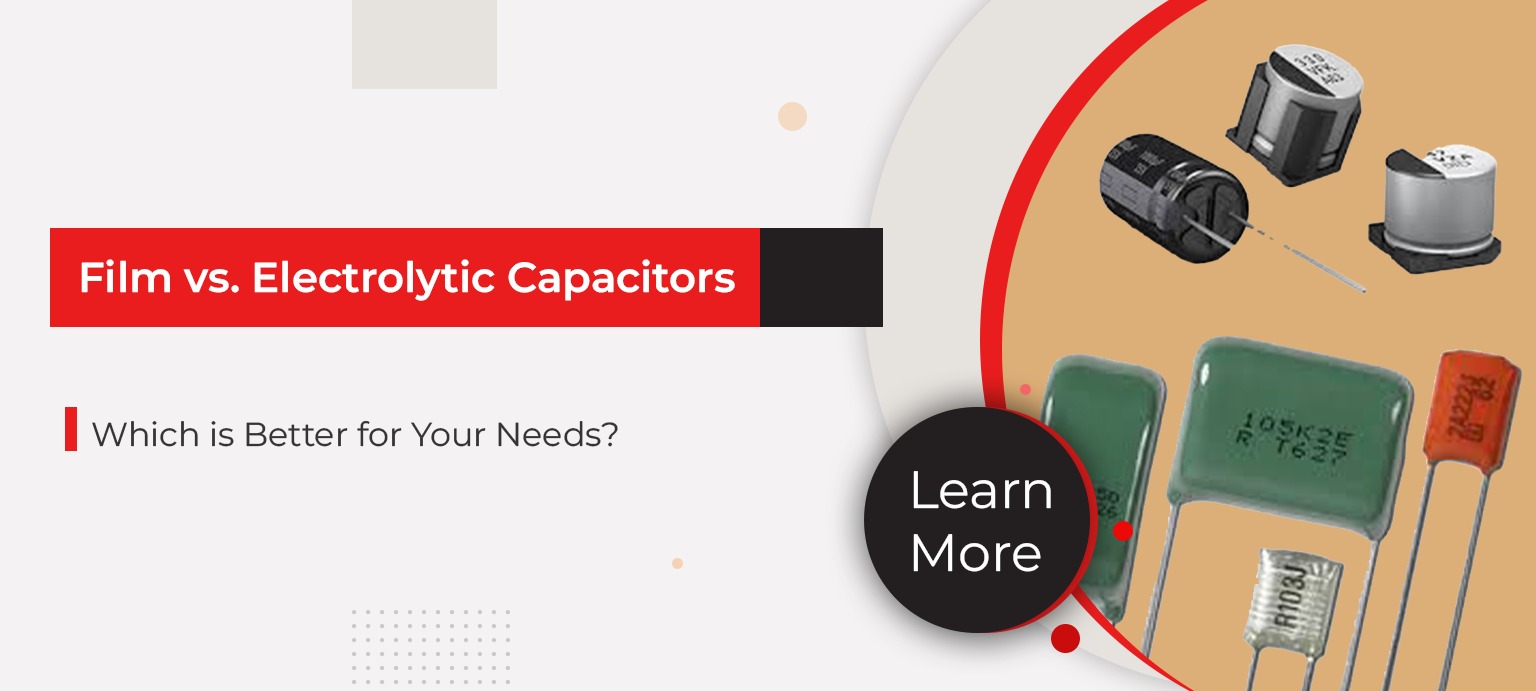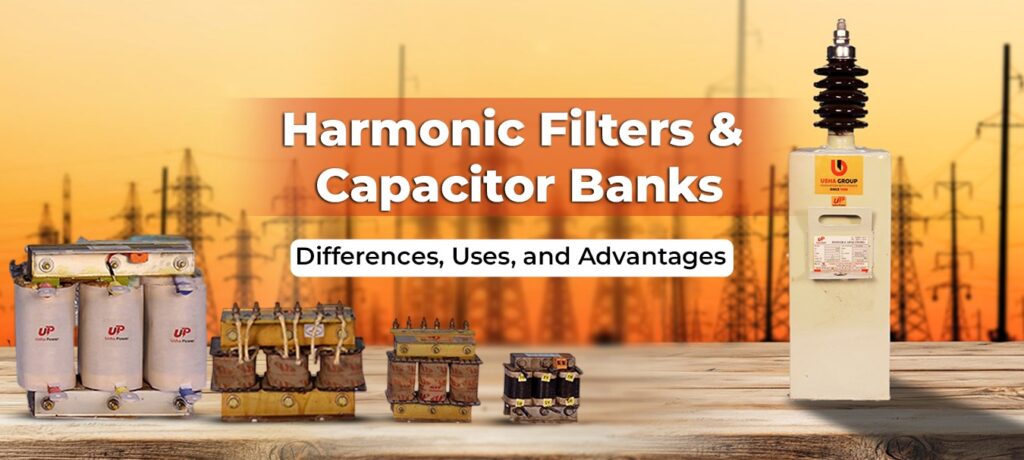Capacitors are essential components in many electrical and electronic systems, serving to store and release energy as needed. Two of the most common types of capacitors used in various applications are film capacitors and electrolytic capacitors. Both have distinct properties and advantages that make them suitable for different situations. The challenge lies in choosing the one that best fits your specific needs.
In this blog, we’ll explore the differences between film capacitors and electrolytic capacitors, their applications, advantages, and limitations. By the end, you’ll have a clear understanding of which capacitor is better suited for your needs.
Understanding Film Capacitors
Film capacitors, also known as plastic film capacitors or polymer film capacitors, are made by depositing a thin layer of plastic film as the dielectric between their metal electrodes. They are known for their stability, reliability, and long lifespan, making them a popular choice in a wide range of applications.
Key Characteristics of Film Capacitors
High Stability: Film capacitors are highly stable over time, meaning they retain their capacitance even after prolonged use.
Low ESR (Equivalent Series Resistance): These capacitors exhibit a low ESR, which reduces energy losses and heat generation, making them highly efficient.
Temperature Tolerance: Film capacitors can withstand a wide range of temperatures without significant changes in their performance.
Durability: They are known for their long lifespan, with little degradation over time, making them ideal for applications requiring high reliability.
Applications of Film Capacitors
Film capacitors are commonly used in:
• Power electronics
• Signal filtering
• Audio applications
• High-frequency circuits
• DC applications
• Timing circuits
Because of their low losses and stability, film capacitors are often preferred in applications where accuracy and efficiency are critical.
Understanding Electrolytic Capacitors
Electrolytic capacitors, on the other hand, use an electrolyte as their dielectric. They are known for their high capacitance values, which makes them useful in applications that require large energy storage in a small footprint. There are two primary types: aluminum electrolytic capacitors and tantalum electrolytic capacitors.
Key Characteristics of Electrolytic Capacitors
High Capacitance: Electrolytic capacitors can store a large amount of energy, which makes them ideal for high-power applications.
Compact Size: Despite their high capacitance, these capacitors are relatively small, which is beneficial in space-constrained designs.
Polarized: Most electrolytic capacitors are polarized, meaning they must be connected in the correct polarity to function properly.
Limited Lifespan: Compared to film capacitors, electrolytic capacitors have a shorter lifespan and can degrade faster, especially under high temperatures or voltage stress.
Applications of Electrolytic Capacitors
Electrolytic capacitors are commonly used in:
• Power supply filtering
• Energy storage for audio amplifiers
• Motor start applications
• Power management in consumer electronics
• DC-link capacitors in inverter circuits
Due to their high capacitance, electrolytic capacitors are essential in applications where large amounts of energy need to be stored and released quickly.
Comparing Film and Electrolytic Capacitors
Now that we have a basic understanding of both film and electrolytic capacitors, let’s compare them across several key factors.
1) Capacitance Range
Film Capacitors: Typically offer lower capacitance values compared to electrolytic capacitors, ranging from a few picofarads (pF) to several microfarads (µF). They are suitable for applications where smaller capacitance is required.
Electrolytic Capacitors: Offer much higher capacitance, with values ranging from a few microfarads (µF) to several millifarads (mF). They are ideal for applications that demand higher energy storage.
2) Size
Film Capacitors: Generally larger in size for the same capacitance value, which can be a disadvantage in space-constrained designs.
Electrolytic Capacitors: More compact, making them a better choice when space is limited.
3) Voltage Rating
Film Capacitors: Can handle much higher voltages, typically ranging from a few hundred to several thousand volts. This makes them suitable for high-voltage applications.
Electrolytic Capacitors: Have lower voltage ratings, usually between 16V and 500V, limiting their use in high-voltage environments.
4) Lifespan and Reliability
Film Capacitors: Are extremely reliable and have a longer lifespan. They are less likely to fail over time, even under challenging conditions.
Electrolytic Capacitors: Tend to have a shorter lifespan, especially when exposed to high temperatures or continuous high voltages. They are more prone to failure compared to film capacitors.
5) Temperature Stability
Film Capacitors: Maintain stable performance over a wide temperature range, making them ideal for applications exposed to varying environmental conditions.
Electrolytic Capacitors: Are more sensitive to temperature fluctuations, and their performance can degrade under extreme heat or cold.
6) Cost
Film Capacitors: Are generally more expensive than electrolytic capacitors, especially at higher capacitance values.
Electrolytic Capacitors: Tend to be more cost-effective, particularly when high capacitance is needed.
Which Capacitor is Better for Your Needs?
The choice between film and electrolytic capacitors depends on the specific requirements of your application. Here’s a guide to help you decide:
When to Choose Film Capacitors
High Voltage Applications: If your system requires handling high voltages, film capacitors are the better option due to their higher voltage ratings.
High Stability and Longevity: For applications that need long-term reliability, film capacitors offer better stability and a longer lifespan.
Precision Circuits: In circuits where precision and low signal loss are critical, such as in audio equipment or high-frequency circuits, film capacitors are superior.
When to Choose Electrolytic Capacitors
High Capacitance Needs: If your application demands high capacitance values in a compact package, electrolytic capacitors are the best choice.
Cost Efficiency: When working within a budget, electrolytic capacitors offer a cost-effective solution for high-capacitance needs.
Power Supply Filtering: Electrolytic capacitors are ideal for smoothing out voltage fluctuations in power supplies due to their large energy storage capabilities.
Final Thoughts
Both film and electrolytic capacitors have unique strengths and limitations, making them suitable for different types of applications. Film capacitors excel in high-voltage, high-precision, and high-reliability scenarios, while electrolytic capacitors are the go-to choice for high-capacitance, space-limited, and cost-sensitive designs.
When selecting the right capacitor, it’s important to evaluate the specific requirements of your system, including voltage, capacitance, size, and reliability needs. By doing so, you’ll ensure that your circuit operates efficiently and reliably, no matter the application.
If you are looking for capacitors for your industrial or commercial projects, Usha Power can provide a range of high-quality, reliable capacitor solutions. We understand the importance of choosing the right component for your specific needs, and our team is ready to assist you in finding the perfect match for your system. Whether you’re dealing with complex high-voltage applications or require cost-effective solutions for large-scale energy storage, we offer products that meet the highest standards of quality and performance. Reach out to us today to explore how our capacitors can power your next project to success.



